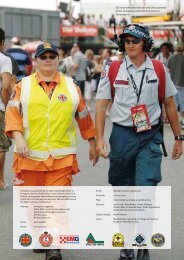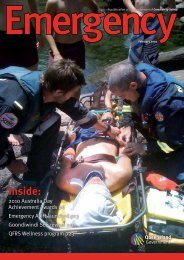Photo by Michael Marston - Department of Emergency Services ...
Photo by Michael Marston - Department of Emergency Services ...
Photo by Michael Marston - Department of Emergency Services ...
Create successful ePaper yourself
Turn your PDF publications into a flip-book with our unique Google optimized e-Paper software.
<strong>Photo</strong>s <strong>by</strong> Mark Cross<br />
Research uncovers<br />
dry slot phenomena<br />
By Femke Mason<br />
This year’s bushfire season is already<br />
well underway and the ongoing<br />
drought and subsequent high fuel load<br />
are presenting a huge challenge for the<br />
State’s fire service.<br />
With these realities facing firefighters,<br />
the availability <strong>of</strong> research that may<br />
provide an insight into the behaviour <strong>of</strong><br />
bushfires comes at a crucial time.<br />
After several years <strong>of</strong> studying weather<br />
and fire patterns, Bureau <strong>of</strong> Meteorology<br />
Research Centre and Bushfire<br />
Cooperative Research Centre (CRC)<br />
scientist, Dr Graham Mills, has revealed<br />
that fire behaviour may be affected <strong>by</strong><br />
what he refers to as ‘dry slots’.<br />
The dry slot phenomena, as described<br />
in an article produced <strong>by</strong> the CRC in<br />
conjunction with Dr Mills, consists <strong>of</strong><br />
columns <strong>of</strong> super-dry air that descend to<br />
the earth’s surface from high altitudes.<br />
When this air reaches the surface, a<br />
rapid loss <strong>of</strong> humidity occurs and causes<br />
extreme drying <strong>of</strong> fuel on the ground,<br />
<strong>of</strong>ten increasing fire activity.<br />
“I’m a meteorologist, not a fire behaviour<br />
scientist, but I understand that fine fuel<br />
moisture content will respond to changes<br />
<strong>of</strong> atmospheric moisture within an hour,<br />
so these extreme drying events will<br />
affect fine fuel moisture,” Dr Mills said.<br />
“It is known that fire activity increases as<br />
the fuel dries, so there is a potential link.<br />
“To what degree this occurs is hard to<br />
say, but these processes have been<br />
observed for Canberra and one or two<br />
other major fires, so it would seem to<br />
be worth making a careful study <strong>of</strong> this<br />
phenomenon.”<br />
Dr Mills said that while these dry slots<br />
occurred in the upper levels virtually on<br />
a daily basis throughout the country, and<br />
could be monitored using specialised<br />
satellite imagery, it is the processes that<br />
lead to this air reaching the surface that<br />
formed the basis <strong>of</strong> his current research.<br />
Preliminary results revealed that this is<br />
more likely to occur in the afternoon,<br />
particularly if the day is hot.<br />
In addition, it would appear that<br />
mountains and wind changes could<br />
also enhance the likelihood <strong>of</strong> dry slots<br />
affecting fire behaviour.<br />
QFRS Assistant Commissioner Rural<br />
Operations, Steve Rothwell, said the<br />
information revealed from the research<br />
would be useful during the bushfire<br />
season.<br />
“This kind <strong>of</strong> research is very important<br />
in our planning for the bushfire season,”<br />
Steve said.<br />
“While unfortunately it’s unlikely we’ll<br />
ever be able to predict fire behaviour,<br />
the knowledge that these kinds <strong>of</strong><br />
phenomena are more likely to occur in<br />
the afternoon and in geographically<br />
diverse areas, means we can increase<br />
firefighter awareness and safety.<br />
“We now have the knowledge that in areas<br />
surrounded <strong>by</strong> mountains, and particularly<br />
in the afternoon <strong>of</strong> a dry and hot day, we<br />
will need to be aware <strong>of</strong> this possibility.<br />
“With the Bureau <strong>of</strong> Meteorology’s<br />
support, this information will further<br />
assist with firefighter safety <strong>by</strong> providing<br />
us with at least some warning <strong>of</strong><br />
potential changes to the fire.”<br />
Both Steve and Dr Mills agreed that<br />
while it would be impossible to completely<br />
control the way a fire behaves, the more<br />
research and understanding that can be<br />
undertaken, the better.<br />
“While mother nature is always going to<br />
be too determined when it comes to fire,<br />
if we can get a better handle on these<br />
types <strong>of</strong> phenomena and provide at<br />
least a few hours <strong>of</strong> warning, then a<br />
hope might be that we can keep<br />
firefighters even safer,” Dr Mills said.<br />
10 EMERGENCY October 2006 www.emergency.qld.gov.au






